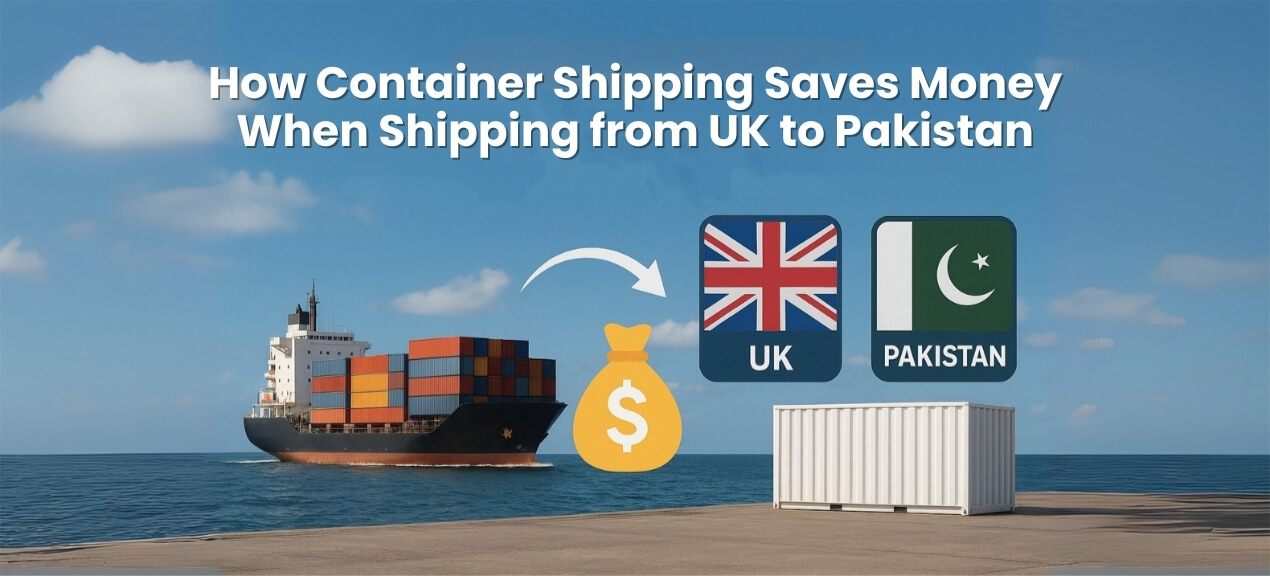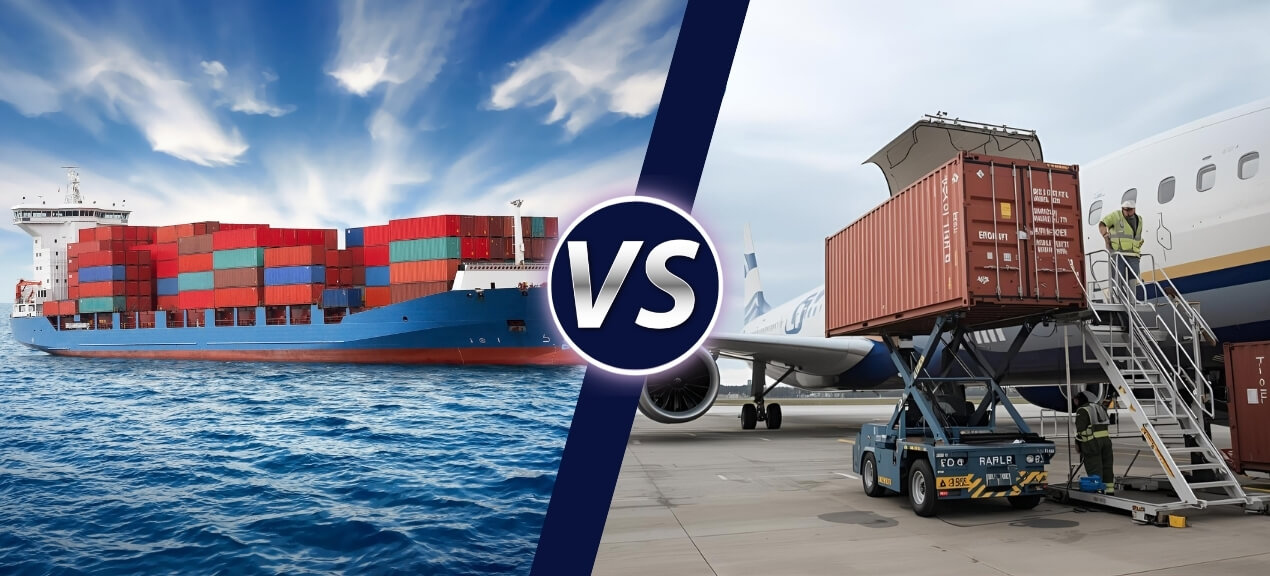
What is Container Shipping?
Container ships are enormous vessels that transport dry cargo using intermodal containers. Container ships, unlike regular cargo ships, use containers of defined size and capacity for shipping goods from UK to Pakistan.
Standard-size containers increase cargo space, providing each ship to transport a maximum number of products, including fresh produce, lumber, and automobiles. These dedicated container ships, which follow a set route and schedule, may efficiently transport goods from one port to another, thereby facilitating worldwide trade. Before container ships, our economy wouldn’t function as it does now. Producing goods in foreign markets would be prohibitively expensive, restricting alternatives for both production and marketing.
Types of Container Shipping (FCL vs LCL)
The capacity occupied by carried products is referred to as shipment volume. This is frequently expressed in units of cubic meters or cubic feet. It is often the decisive element between LCL and FCL deliveries.
LCL vs FCL
FCL shipping UK to Pakistan are typically preferable for low-volume shipments ranging from 2 to 13m3. Under specific conditions, LCL can also be used to ship merchandise smaller than 2m3.
FCL shipments are often less expensive when they contain more than 10 conventional pallets or take up more than 14m3.
Freight Surveillance
It is normal for all shippers to want their cargo to be safe while crossing the oceans. However, not all packages require the same level of security. Certain shipments are especially sensitive to the changes and motions to which cargo is frequently subjected during shipping.
FCL vs. LCL: An FCL shipment is typically more safer because it has exclusive rights to the full container. This implies it is not in contact with cargo from other carriers, as is the case with LCL transportation, and is not at risk of harm or contamination from other items.
FCL shipping UK to Pakistan may, nevertheless, be a safer option for certain cargoes. Low-volume cargoes are more tightly packed, leaving less space for mobility.
Shipping expenses
Shipment cost from UK to Pakistan is one of the most important things to consider when determining whether to ship FCL or LCL.
FCL vs. LCL: The usual rule of thumb is to use LCL shipping UK to Pakistan for low-volume shipments (between 2 and 13m3) and FCL for higher-volume shipments (13m3 and up), even if the container is not totally full. However, this principle is not set in stone. Under some conditions, it may be preferable to LCL shipping UK to Pakistan, even for volumes under 13m3. If you are unsure whether to ship FCL or LCL, explore both choices and get guidance from your freight forwarder. The stability of FCL and FCL shipping UK to Pakistan rates varies. In general, FCL shipping rates tend to be more volatile than LCL shipping rates, which are often more steady.
Urgency of shipment
It is vital to prepare a cargo ahead of time, but things do not always go as planned, and circumstances may prevent it. Aside from pricing, another consideration when choosing between FCL and LCL is how quickly your cargo needs to get at its destination.
FCL vs. LCL: LCL shipping UK to Pakistan is usually the best choice for urgent shipments or shipments that must arrive by a specific date. LCL is better suited to shipments with changeable dates.
Aside from transshipments, LCL transports are particularly prone to delays due to the various handlings they undergo during the shipping process. LCL goods must be unloaded and loaded whenever they travel at a transshipment port.
Why Container Shipping is Cheaper for UK to Pakistan
Global trade, building, and even domestic efforts rely on container ships for shipping goods from UK to Pakistan as much as ever. Knowing the cost of shipping containers can allow you to make intelligent purchasing decisions and save money, whether you’re looking for a container for a custom project or one for store or transit. In this blog, we will look at the factors that influence pricing, the differences among new and used containers, cost-cutting techniques, and more. The how to save money on container shipping varies according to size, state of affairs, the location, and market demand. This article will go over container price basics and offer tips to help you save money.
Bulk Transport Reduces Cost Per Unit
Benchmarking is an effective technique to compare performance and costs to a similar set of counterparts or competitors. In ocean container shipping, comparing entails comparing rates amongst carriers and suppliers based on service levels, trade lanes, and other factors. This information can provide you with significant influence in carrier contract talks.
Shared Space (LCL) Cuts Overall Costs
Gather industry information from trade journals, publically available indices, market reports, and carriers for both 20- and 40-foot containers. Next, compared rates for identical trade lanes, routes, and types of service. Consider additional issues such as additional fuel costs, transit delays, maritime capacity, dependability of service, and transportation or service provider rating.
A benchmarking study can help you book more efficiently, but it can be challenging and time-consuming. This is where an acknowledged how to save money on container shipping with training in benchmarking and passenger relations may help you save money on container shipping expenses.
Sea Freight vs Air Freight – The Cost Difference Additional Benefits of Container Shipping

It transports a wide range of items, including petroleum products, raw materials, and industrial equipment, as well as automobiles, fruits, dairy, meat, and clothes. Goods are transported on massive container ships that may hold between 10,000 and 21,000 TEUs. There are even larger container ships.
Advantages of Sea Freight
- Sea freight is a cost-effective way to carry goods across vast distances.
- It is also a sustainable option for international shipping.
- Suitable for large volumes.
Disadvantages of Sea Freight
- It takes longer than breathe road, and rail freight.
Air Freight
Air freight is best suited for modest volumes of products that must be shipped rapidly. This is also a fantastic alternative for high-value items and express shipping. Air freight transports cargo on unit load devices (ULD), which might be pallets or containers. ULD pallets are aluminum plates that may be fitted into the hold of cargo and fastened in place. The cargo on these pallets is safeguarded with nets. ULD containers, which are enclosed boxes utilized in air cargo, are composed of aluminum or an alloy of aluminum and plastic.
Advantages of Air Freight
- Air freight transports high-value products quickly and securely.
- Reliable in terms of time and speed.
Disadvantages of Air Freight
- Higher cost opposed to rail, road, or sea freight. • Lower sustainability than sea freight.
Tips to Save More on Container Shipping
A shipping goods from UK to Pakistan with a network that includes these carriers can be extremely useful in this situation. These truckers have specific tools and the necessary permissions from transportation departments to haul heavy loads.
Optimize container loading
Such software aids in optimizing loading and allocation of weight based on the shape and weight input.
Understand when it makes more sense to utilize a 20-foot container over a 40-foot one. Another alternative is to use a high-cube container, which allows for higher pallet stacking. This makes sense for lighter, denser things that cube out rapidly before exceeding the weight limit.
Be adaptable with scheduling
Another strategy to cut container shipping prices is to be flexible with your ship time demands, as slower shipping typically results in lower rates. As you know from plane travel, rates can fluctuate substantially depending on the day, week, or season. The same is true for shipping lines.
Shipping when demand is low saves money because carriers provide more competitive rates to load their vessels and better utilize capacity, avoiding empty or partial sailings. Shippers with variable sailing timings will also profit from reduced port wait times and faster total transit times, which will reduce delays and expenses.
Is Container Shipping Right for You?
Remember that shipping companies are not encouraged to have you minimize your container load weight. Do not allow their advise prevent you from saving money by increasing cargo capacity and shipping lower bins.

 07424380227
07424380227